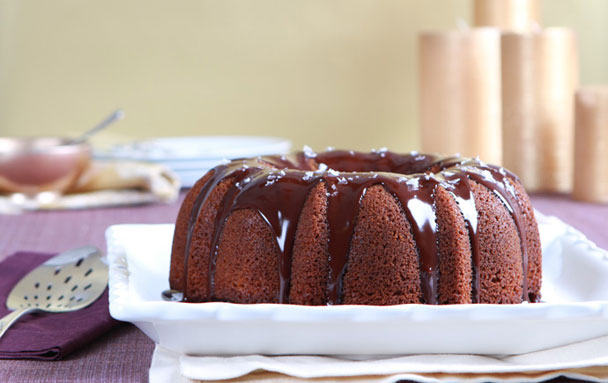
If spice cake is your idea of heaven, then you’ve got to try this latest incarnation. I guarantee my super–moist version, redolent of sweet spices, will become your go–to recipe for fall and winter events. The cake is as simple to put together as a batch of brownies, and it keeps for at least a week, improving in flavor and aroma as the days go by. What's more, the equipment required to make it is about as low–tech as it gets in baking: a whisk, two bowls—one for the dry ingredients and one for the wet—and a Bundt pan. Oh, and it just happens to be ideal for Rosh Hashanah, coming up on September 28.
Honey cake goes hand in hand with Rosh Hashanah, the Jewish New Year, because honey symbolizes the wish for sweet things to come in the year ahead. It’s a time for families to gather and celebrate, and there’s nothing quite like cake to signal a special occasion. No wonder, then, that honey cake—also referred to by its Yiddish name, lekach—is as much a fixture at Rosh Hashanah as it is at weddings.
With the holiday on the horizon, I made it my mission to find the best of the honey cakes Gourmet magazine had run in recent decades. This would be my starting point, a foundation for a 21st–century take on this dessert tradition. I tried a bunch of recipes, and the winner among my colleagues and tasters at Gourmet Live was one by Sue Hubbell, author of A Book of Bees: And How to Keep Them, that accompanied her February 1999 Gourmet article, “Bees and Honey.” A great benefit of cooking with honey, as Hubbell explained in her article, is that because this sweet substance is low in water content, it readily absorbs moisture from the air—a property scientists call hygroscopicity. Practically speaking, it means honey keeps baked goods moist and fresh–tasting for a while.
Rosh Hashanah honey cakes are dairy–free, in keeping with Jewish dietary laws (kashruth), which—simply put—forbid eating meat and dairy together at the same meal. Rosh Hashanah is traditionally a meat meal, featuring classics such as braised beef brisket or roast chicken. So in my honey cake, coffee replaces milk or buttermilk in the batter, and vegetable oil substitutes for butter—all of which will be welcome news to anyone with lactose intolerance.
In fact, the oil is another reason why honey cake is so moist; there’s nothing like it to give baked goods an incredibly moist crumb. (Pssst! Oil is the secret behind carrot cake’s popularity.) Looking back on the Glorious Red, White, and Blue Cake recipe I created for the Fourth of July, which baked into the most tender cake layers I’ve ever eaten, I figured I could push the envelope on Hubbell’s cake and increase the oil slightly. What a difference an extra quarter cup makes! It’s not that the original wasn’t moist. It’s just that my new version is even more so, in a very dreamy way.
After reading through countless honey cake recipes, each with its author’s signature addition—perhaps a dash of a favorite spice, a touch of citrus zest, or a shot of liquor, for instance—I couldn’t help tweaking Hubbell’s recipe to see where these extra flavor layers might go. It’s hardwired into recipe developers to play the what–if game. What if I add a little bit of this or a tad of that? We recipe developers are inveterate tinkerers.
I found that many recipes added a hint of citrus, so in went orange zest, along with ground ginger to round out the spice profile. Each addition was met with a serious critique by my colleagues. Even when I finally got unanimous thumbs–up approval, I still wasn’t quite satisfied. The cake needed what the fashion police call “accessorizing.”
Despite its status as a holiday dessert—one you’d expect to be on the fancy side—honey cake often gets short shrift when it comes to presentation. I was surprised to find many instances in Gourmet, as well as in authoritative Jewish cookbooks, in which honey cake was baked in a plain loaf pan with only the occasional adornment of a few sliced almonds. That didn’t sound like party food to me.
At least Hubbell’s honey cake was cooked in a Bundt pan, which dresses up any cake quite nicely. The ring shape happens to be another New Year’s symbol, reinforcing the idea of the cycle of life as people reflect on the past and look forward to the future.
Yet the cake cried out for a glaze to top it off, the way an artfully placed scarf turns a dress into an outfit. My motto has long been that just about everything goes better with chocolate, and in all seriousness, chocolate and spice do make a dynamic duo. Ganache, that sublime mixture of chocolate and cream, would have been my choice to drizzle over the cake, but dietary laws rule out the cream. I consulted a baker friend well versed in kashruth, who recommended unsweetened coconut milk. It provides the creamy liquid that ganache requires, while the coconut flavor is completely masked by the chocolate. A little light corn syrup provides a gloss that doesn’t wane, and when the glaze is slowly poured over the golden brown ring, it drapes like molten velvet over the cake’s curves and valleys.



 Pinterest
Pinterest


